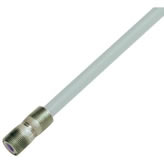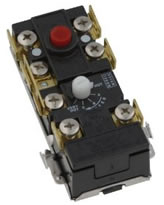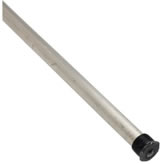- Shortage of hot water
The most common water heater faults associated with a shortage of hot water are:
- Larger water heater is required.
- The dip tube, as shown in Figure 4, is damaged and is permitting the cold and hot water to mix in the water tank.
- One of the heating elements, as shown in Figure 5, is defective.
- The thermostat, as shown in Figure 6, is defective.
- Water temperature is set to low.

Figure 4 - Hot water heater dip tube

Figure 5 - Hot water heater element

Figure 6 - Hot water heater thermostat
Troubleshooting:
Note: If you have had any new plumbing work done in the house, such as the addition of a built-in dishwasher and/or a kitchen or bathroom renovation it is possible that the plumber inadvertently crossed the cold and hot water pipes. This can be easily checked. Turn off the water to the hot water tank and turn on any faucet in the full hot position. If water exits the faucet you have a crossed water line.
If you are experiencing a continuous supply of lukewarm water it is most likely caused by a defective upper heating element.
If you are experiencing hot water, but the hot water supply is limited, it is most likely caused by a defective lower heating element.
It is not uncommon to experience a change in the use of hot water within a home as children grow-up and the shower, dishwasher and clothes washer are used more often. For day-to-day operation a water heater should only operate at 75% of its rated capacity. As an example; a water heater that is rated for 40 gallons per hour should only be required to provide 30 gallons per hour. By having a 25% buffer, you should not run out of hot water.
Check the dip tube by removing the incoming water pipe and the nipple that is attached to the tank. Below the nipple is the dip tube. Inspect the dip tube and ensure that there are no cracks along its length and that it is sealed at the nipple.
Using a multi-meter verify that neither of the heating elements is showing an open circuit. If an open circuit is indicated, replace the heating element.
Ensure that the upper and lower elements are receiving power.
Check thermostat to ensure that it is providing power to the electrical elements when required.
Open the drain on the tank and see if the water is clear. Sediment build-up in hot water tanks can be a problem. The problem is worse in areas that have hard water.
- Water has a reddish brown color
The most common water heater faults associated with a water having a reddish brown color are:
- There could be corrosion inside the hot water tank.
- Most electric hot water tanks have a sacrificial anode rod. The anode rod is installed to prevent the inside of the tank from rusting. As time progresses the anode rod dissolves and will eventually be nonexistent.

Figure 7 - Magnesium hot water heater anode rod
Troubleshooting:
The anode rod is made of magnesium or aluminum that's formed around a steel core wire and is screwed into the top of the tank. A six-year-warranty residential tank will have one, while a 12-year-warranty tank will have two, or an extra-large primary anode.
Replace sacrificial anode rod with magnesium anode rod, as shown in Figure 7.
Note: Magnesium is a much better material for the anode rod than aluminum.
